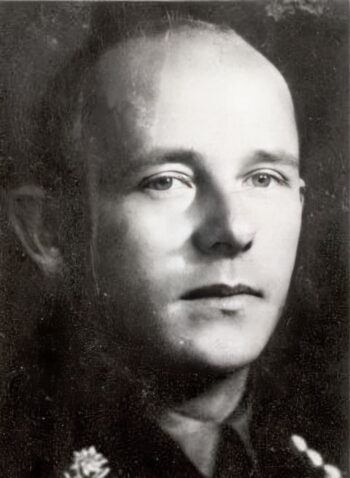Höfle, Hans

Hans Höfle (19 June 1911 – 21 Aug. 1962), SS Sturmbannführer, was Odilo Globocnik’s deputy chief of staff. As delegate for Jewish resettlement in the Lublin District, he was deeply involved within the Aktion Reinhardt in organizing the deportation of Jews from German-occupied Poland to the Majdanek Camp and through the camps at Belzec, Sobibór, and Treblinka, and in the looting of Jewish property and valuables.
Most famously, Höfle is the author of a telegram sent on 11 January 1943 to the commander of the security police in Krakow. This telegram was intercepted and deciphered by the British, who documented and archived it. The telegram gives the reported numbers of arrivals (Zugang) within “Operation (Einsatz) Reinhar[d]t” for the last two weeks of 1942, and totals as of end of 1942 for locations abbreviated with L, B, S, and T, which are commonly interpreted as Lublin (Majdanek), Belzec, Sobibór and Treblinka. The figures are:
| Location | Last fortnight 1942 | Totals |
|---|---|---|
| L[ublin] |
12,761 |
24,733 |
| B[elzec] |
0 |
434,508 |
| S[obibór] |
515 |
101,370 |
| T[reblinka] |
10,335 |
713,55[5] |
| Total |
1,274,166 |
If we deduct the single totals of L, B and S from the overall total, the resulting figure for T is 713,555 rather than 71,355 as given in the telegram, so the figure for T is probably missing a “5.”
Nothing in this document indicates that the Jews deported to these locations were killed there. In fact, even mainstream historians agree that Jews sent to Lublin-Majdanek in 1942 were not subjected to wholesale mass murder there, so the word “Zugang” used by Höfle to describe what happened to the Jews sent to these camps means just that: they arrived there.
The total reported by Höfle in this telegram was later used by SS statistician Richard Korherr in his report about the fate of Europe’s Jews as of the end of 1942, where these Jews are listed under the category of “Transport of Jews from the Eastern provinces to the Russian East.” This category has two entries, one for the Chełmno Camp (145,302 Jews), and one for Jews processed “through the camps in the General Government,” listing precisely Höfle’s figure: “1,274,166 Jews.” Such figures are compatible with deportations of Jews, but we have no evidence at all for the murder of such numbers of people at those camps. (See Mattogno 2004a, p. 127; Graf/Kues/Mattogno 2020, pp. 311-330)
Höfle was captured by the British in 1945, who handed him over to Austria in 1947, where he was soon released. He was arrested again in 1961 for allegedly organizing the deportation and murder of more than a million Jews. However, because Höfle evidently not only refused to “confess” but must have thrown quite a few monkey wrenches into the investigations, the Vienna prosecutors had problems compiling a formal indictment, in spite of the substantial material they had accumulated. On 21 August 1962, just prior to the opening of the trial, Höfle is said to have hanged himself in prison.
The truth is that the Austrian judiciary could not afford a trial against a defendant who knew everything that really had happened, who knew he could expect no mercy no matter how hard he tried to please the court, and who therefore most likely was going to speak the truth. Austrian officials could not allow this, and thus there is a fair chance that they “encouraged” his suicide. (See Graf/Kues/Mattogno 2020, pp. 197f.)

You need to be a registered user, logged into your account, and your comment must comply with our Acceptable Use Policy, for your comment to get published. (Click here to log in or register.)